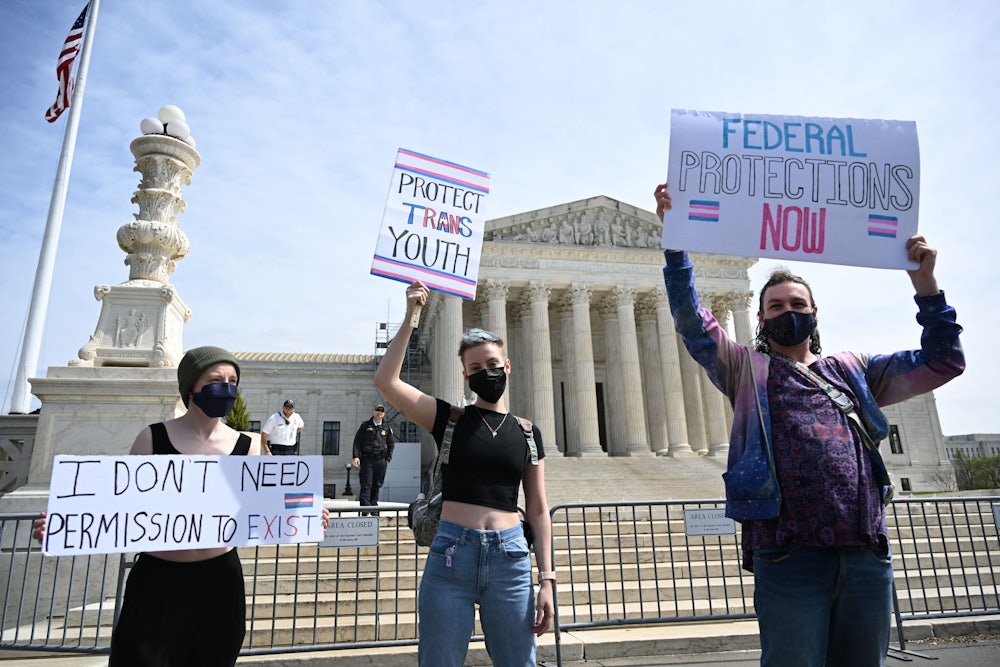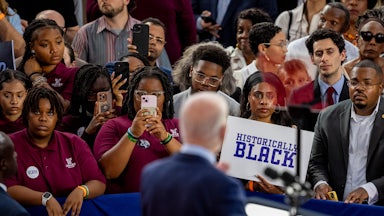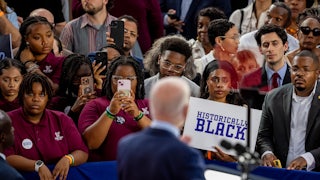The Supreme Court announced on Monday that it will hear a challenge to Tennessee’s ban on gender-affirming care for minors, setting up a major fall-term showdown over transgender rights and the Constitution. That battle will be extraordinarily difficult for transgender rights advocates to win—and the justices appear to have designed it that way.
At issue in United States v. Skrmetti is Tennessee Senate Bill 1, which was enacted in March 2023. It generally bans physicians, hospitals, and other medical professionals in the state from prescribing drugs or performing surgeries that would “[enable] a minor to identify with, or live as, a purported identity inconsistent with the minor’s sex” or “[treat] purported discomfort or distress from a discordance between the minor’s sex and asserted identity.”
Tennessee passed S.B. 1 alongside other laws aimed at transgender Americans, including a statutory definition of “sex” that excludes them, a ban on transgender student-athletes competing in events under their preferred gender identity, and more. Three transgender Tennessee minors, their parents, and a physician sued to challenge S.B. 1 on a variety of grounds, including the equal protection clause, the due process clause, parental rights, and more. The Biden administration also intervened in the case on equal protection grounds.
In equal protection clause cases, courts use different tiers of scrutiny to interpret laws that treat people differently. The higher the level of scrutiny, the more difficult it is for a law to survive. At one end of the spectrum is what’s known as “rational basis” scrutiny, meaning that it survives so long as the government can demonstrate a rational basis for it.
At the other end is “strict scrutiny,” which is reserved for laws that discriminate on the basis of certain immutable personal characteristics, such as race, religion, and national origin. Those laws are presumptively unconstitutional unless the government has an exceptionally urgent and necessary reason for passing them, and it almost never does.
Somewhere in the middle is “heightened scrutiny,” also known as “intermediate scrutiny.” While race, religion, and national origin are eligible for strict scrutiny, the Supreme Court has held that sex is one step below those categories. Laws that discriminate on the basis of sex are considered more permissible than racially or religiously discriminatory laws, but they still receive more scrutiny than the baseline.
Last year, federal district court ruled in favor of the minors, their parents, and the Justice Department on equal protection clause grounds and issued an injunction to block S.B. 1. (The lower courts addressed the other claims as well, but I’ll come back to those later.) Judge Eli Richardson concluded that transgender Americans are a protected class that’s eligible for heightened scrutiny. He also ruled that even if they weren’t, they would fall under the existing framework for sex-based discrimination.
Accordingly, Richardson concluded that S.B. 1 failed to meet the threshold necessary to pass muster under heightened scrutiny. “The Court acknowledges that the state feels strongly that the medical procedures banned by SB1 are harmful to minors,” he wrote. “The medical evidence on the record, however, indicates otherwise.” He cited the positions of the American Academy of Pediatrics, the American Medical Association, and other major medical organizations, which have held that puberty blockers and hormone therapy can be “appropriate and medically necessary treatments for adolescents when clinically indicated.”
Tennessee appealed Richardson’s ruling to the Sixth Circuit Court of Appeals, which overturned it last September. Writing for the majority, Judge Jeffrey Sutton rejected the equal protection arguments on both levels by holding that the laws were not discriminatory at all. “The laws regulate sex-transition treatments for all minors, regardless of sex,” he wrote. “Under each law, no minor may receive puberty blockers or hormones or surgery in order to transition from one sex to another. Such an across-the-board regulation lacks any of the hallmarks of sex discrimination.”
He also held that transgender Americans were not a “suspect class,” a legal term used to describe the groups for whom higher levels of scrutiny apply. Sutton rejected it based on the prongs of the test that courts typically use to determine this. He argued that being transgender is not an “immutable characteristic” because a small number of transgender people later “detransition.” He rejected claims that they are “politically powerless” because the Justice Department and most major medical groups are on their side. He claimed there was no evidence that S.B. 1 was driven by “animus.”
“The unsettled, developing, in truth still experimental, nature of treatments in this area surely permits more than one policy approach, and the Constitution does not favor one over the other,” Sutton concluded, quoting from precedent. “This ongoing debate provides ‘persuasive evidence’ that Kentucky and Tennessee could choose fair-minded caution and their own approach to child welfare, just as other jurisdictions could rationally adopt another path.”
An entire generation of Americans has now lived with a Supreme Court that is, at minimum, not hostile to LGBTQ rights. But the “T” in “LGBTQ” has never really come before the court until now. Skrmetti will be the first Supreme Court case that specifically addresses transgender Americans’ constitutional rights on their own.
The justices handed down a series of rulings over the past three decades that expanded gay and lesbian Americans’ rights and protections, culminating in 2015’s landmark Obergefell v. Hodges ruling, which struck down same-sex marriage bans nationwide. Some of those rulings also benefited transgender Americans, but they were not the focus of them and the justices did not address their specific circumstances.
The court’s first and only brush so far with transgender-specific issues came only four years ago. In 2020, the high court ruled in Bostock v. Clayton County that Title VII of the Civil Rights Act of 1964, the main federal workplace-discrimination law, covered sexual orientation and gender identity. Title VII generally bans employers from discriminating “on the basis of sex.” Justice Neil Gorsuch, who wrote for the 6–3 majority, held that this specific language also applied to gay and transgender workers.
“An employer who fires an individual for being homosexual or transgender fires that person for traits or actions it would not have questioned in members of a different sex,” he wrote. “Sex plays a necessary and undisguisable role in the decision, exactly what Title VII forbids.” Chief Justice John Roberts and the court’s four liberal justices at the time joined his decision.
While the Bostock ruling was a major victory for the plaintiffs in that case, there are reasons to doubt that a similar majority will emerge in this case. For one thing, Ruth Bader Ginsburg’s death and replacement by Justice Amy Coney Barrett shifted the court further to the right. If one uses the Bostock majority as the starting point for a potential ruling, it starts at 5–4 instead of 6–3.
The Bostock ruling was also narrowly tailored to the case at hand. Gorsuch’s decision only addressed a particular statute—in that case, Title VII—and did not automatically extend to similar anti-discrimination laws for housing and public accommodations. In Title VII cases, the court has regularly held that the statute’s text prohibits conduct that would not have necessarily been seen as discriminatory by its drafters, such as sexual harassment. (The law was passed in the Mad Men era, after all.) And as a statutory interpretation case, it does not serve as precedent on its own for a constitutional law case.
The Supreme Court has also avoided taking up cases in recent years in which Americans might be more sympathetic to the transgender plaintiffs. As recently as January, the court has left lower court rulings intact that allow transgender school students to use the bathrooms that match their gender identity. A Pew Research Center survey in 2022 found that 64 percent of Americans support laws that prohibit discrimination against transgender Americans in “jobs, housing, and public spaces.” Forty-six percent of Americans, by comparison, said they favored laws that banned medical professionals from helping minors transition.
When taking up Skrmetti, the justices also conspicuously declined to consider other pending appeals that involve state bans on gender-affirming care. This is more meaningful than it might seem at first glance: The Biden administration originally intervened in the Tennessee case under a federal law that allows it to intervene in certain lower court cases where the equal protection clause is implicated. As a result, its appeal focuses solely on that question.
The three transgender Tennessee minors and their parents who originally filed the lawsuit had also filed a petition for justices to review the Sixth Circuit’s ruling on other grounds. Richardson had ruled in favor of the parents’ right to make medical decisions for their children on due process clause grounds; the Sixth Circuit panel rejected that argument. The Justice Department had urged the court to accept its petition and consolidate it with the other plaintiffs’ appeal so it could hear all sides. The court silently declined to do so on Monday and left the other petitions hanging, so to speak. That would allow them to sidestep the other issues—and their optics—until after they hand down a ruling on the narrower grounds that they chose.
Finally, there is the lower court’s ruling itself. Sutton framed his ruling in small-c conservative terms, arguing that the issue of gender-affirming care—and transgender issues in general—is too novel for courts to “constitutionalize” under the Fourteenth Amendment. “Life-tenured federal judges should be wary of removing a vexing and novel topic of medical debate from the ebbs and flows of democracy by construing a largely unamendable Constitution to occupy the field,” he wrote.
When the Supreme Court decides to take up an appeal, its most fundamental decision is whether to affirm or reverse the lower court’s ruling. Sutton made the conservative justices’ job as easy as possible. He narrowly interpreted the court’s equal protection clause precedents without defying them and framed the decision as one of judicial humility and democratic debate. The court’s conservative justices, who spent most of this term repairing the shoddy overreaches of the Fifth Circuit, probably wanted to hug him when they read it.
Chief Justice John Roberts, who took an almost identical approach in his dissent from Obergefell nine years ago, will likely be receptive to this line of reasoning. “Understand well what this dissent is about: It is not about whether, in my judgment, the institution of marriage should be changed to include same-sex couples,” he wrote. “It is instead about whether, in our democratic republic, that decision should rest with the people acting through their elected representatives, or with five lawyers who happen to hold commissions authorizing them to resolve legal disputes according to law.”
The net result of the court deciding to hear Skrmetti is that the justices are taking up what will likely be a landmark case on transgender rights where no transgender person is actually a plaintiff, where the now-faceless dispute can be reduced to a battle between the Biden administration and Tennessee Republicans, and where questions of constitutional rights and equal protection can be glazed over by paeans to the laboratories of democracy. In short, the Supreme Court has done everything it possibly can to engineer a palatable case for eliminating equal protection claims for transgender Americans if it wishes to do so.








